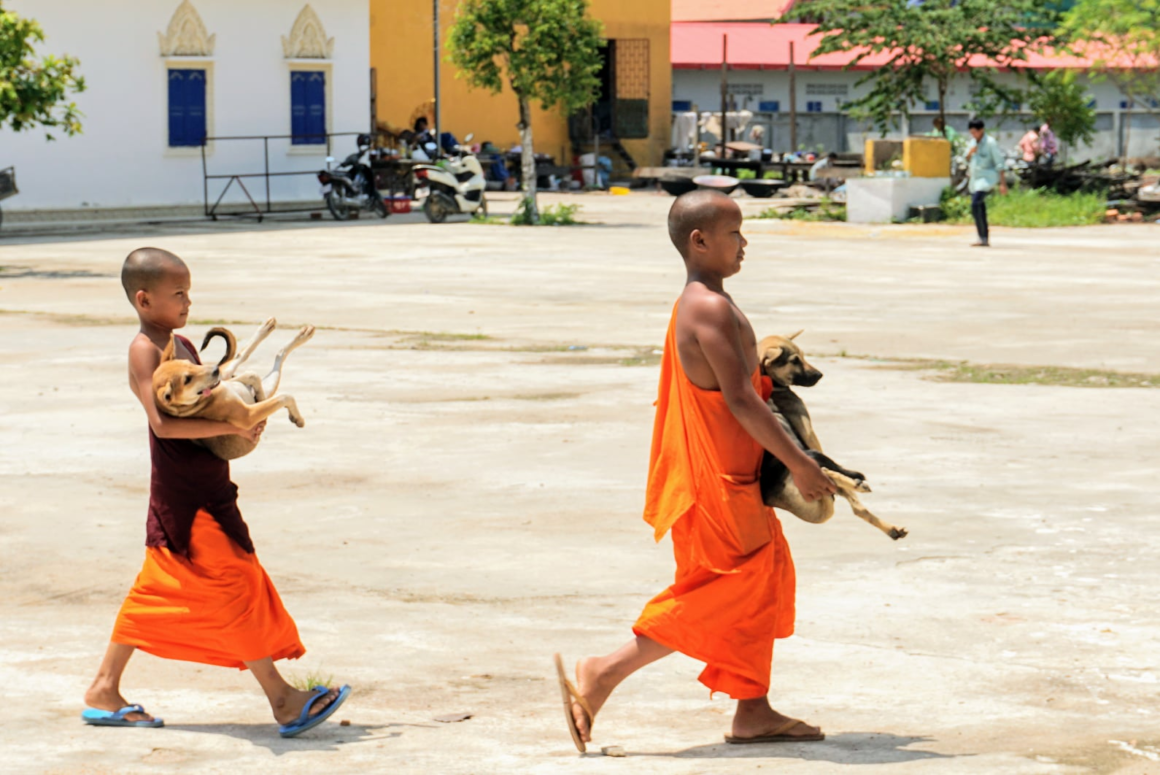ចុចត្រង់នេះដើម្បីអានអត្ថបទជាភាសាខ្មែរ។.
In this article, the experts at Animal Rescue Cambodia (ARC) will answer the most important aspects you need to know about the welfare of street animals in the Kingdom of Cambodia.
- Overview of Animal Welfare in Cambodia
- Millions of Stray Animals in Streets & Pagodas
- Eradicating Dog & Cat Meat Trade/Consumption is Challenging
- Rabies is Still a Big Deal
- The Importance of Spaying/Neutering
- Pets in Cambodia
- How to Improve Animal Welfare in the Kingdom
Let’s get started right away.
1. Overview of Animal Welfare in Cambodia
In Cambodia, animal welfare is still in its infancy. Animals in general, and cats and dogs in particular, are often considered as a nuisance, food, or property.
Understandably, due to more pressing challenges in the country, there is a lack of knowledge, understanding, and urgency about caring for animals. Consequently, there are high rates of abuse and neglect. Besides, dogs and cats are often sold for meat.
Desexing is not common and is thought to bring bad karma in Buddhist beliefs, so overpopulation is a major concern. Besides, this overpopulation contributes to the spread of rabies and other diseases.
2. Millions of Stray Animals in Streets & Pagodas
Cambodia is home to millions of cats and dogs, most of them stray. As part of their rabies research, The Institut Pasteur Du Cambodge identified that there are around 5 million dogs in the Kingdom, most of them strays. Sadly, the situation for cats is even worse.
Lack of means and access to vet care forces people to abandon their cats and dogs – often at pagodas which are thought to be a safe haven. Unfortunately, pagodas are not safe for animals.
The monks and residents are often overwhelmed by the large numbers, sharing the little they have with the cats, dogs, and other abandoned animals.
However, their means are severely limited, especially during a hardship like the Coronavirus situation. Besides, they often lack the knowledge of how to care for animals.
Especially during the night time, dogs and cats are often stolen for their meat. Moreover, we receive reports from pagodas and their head monks that they are so overwhelmed by the number of animals, that they don’t want to have them at their pagodas anymore. They then give the cats and dogs to people, who supposedly take them to the countryside where they can live freely and happily. But we believe that this is a cover story and that these cats and dogs are actually being slaughtered for their meat. Dogs may end up in the dog meat trade and cats are often eaten by very poor people.
3. Eradicating Dog & Cat Meat Trade/Consumption is Challenging
2-3 million dogs are slaughtered every year for their meat in Cambodia. With many misconceptions, that dog meat is healthy and has superpowers, this unfortunate trend is only slowly disappearing.
The truth is that preparing and eating cat and dog meat can actually make you very sick! For example, you can get rabies, Cholera, and many other diseases and parasites.
In fact, Siem Reap used to be a dog meat hotspot until July 2020, when dog meat was officially banned in Siem Reap province due to the efforts and collaboration between Animal Rescue Cambodia, FOUR PAWS International, and the Siem Reap Provincial Government.
Despite these efforts, unfortunately, especially dog meat is still popular. This is why the continuous efforts of animal welfare advocates are so important.
4. Rabies is Still a Big Deal
According to the World Health Organization, every year, rabies still causes approximately 59,000 deaths worldwide. 95% of these cases occur in Africa and Asia. And in Cambodia, around 800 people die every year from rabies as referenced by the Institut Pasteur du Cambodge.
Rabies is often transmitted through bites of wild or stray animals like dogs, who have rabies themselves. But the solution is so easy: there is a vaccination for humans and animals, both as a preventative measure and as an emergency treatment after a (potential) infection.
ASEAN plans to eliminate rabies before 2025 and the Pasteur Institute in Paris is researching to reduce the number of necessary vaccine injections.
On a local level, Animal Rescue Cambodia is collaborating with Mission Rabies, the General Directorate of Animal Health and Production (GDAHP) of the Ministry of Agriculture, the Ministry of Education, and other partners to eradicate this deadly disease. In 2019 alone, ARC administered more than 6,000 rabies vaccinations to stray animals.
5. The Importance of Spaying/Neutering
To begin with, we have an interesting question for you: ‘How can one person avoid the suffering of more than 2,000 puppies and more than 11,000 kittens in just 6 years?’
The answer is as simple as astounding: Just 1 female dog, her mate, and their offspring can produce over 2,000 new dogs (average litter of 4, once a year) in just 6 years. And the same goes for cats, where 1 female cat, her mate, and their offspring can create more than 11,000 new cats in just 6 years.
These large numbers are considered overpopulation. And with nowhere to go, no loving home, these animals are stolen by meat traders for the barbaric cat and dog meat trade. Unwanted cats and dogs are often dumped at pagodas, leaving them sick, malnourished, and fighting for survival. Therefore, desexing (spaying female cats/dogs and neutering male cats/dogs), can save thousands of precious lives.
Besides, desexing has many other benefits for your beloved pets. These include healthier cats and dogs (reduced risk of testicular and uterine cancer, FIV, TVT), prevention of inbreeding, and calmer animals with less territorial fights and aggression.
6. Pets in Cambodia
Companion animals are gaining more and more popularity in the Kingdom. In fact, pets are a great addition to any family. They help to relieve stress, boost your immune system, encourage playfulness, and are great for children to develop relationships and learn how to care for others. At the same time, owning a pet also comes with financial and emotional responsibilities.
A few things to keep in mind
- Wildlife belongs in the wild → it is illegal in Cambodia to keep wildlife as pets. Admire eagles, bears, tigers & co. in the wild, where they belong!
- Adopt Don’t Shop → When choosing a companion animal, adopt a rescue cat or dog rather than buying an animal from a pet shop or a breeder. Pet store animals are often sick and tend to have behavioral problems. Likewise, kitten/puppy mills exploit the mother cats and dogs, often treating them poorly.
- Keep your pet healthy → Make sure your beloved pet is microchipped, vaccinated, and gets his/her regular health check-ups from a professional veterinarian like VSL Veterinary Clinic.
- Relocating with your pet → Remember that pet adoption is for life. Start getting your pet ready as early as possible, e.g. regular vaccinations, microchipping. Keep in mind that the relocation preparation, and especially the paperwork, can take several months. Consult with an experienced vet or clinic as the information online is often outdated. Get started with our checklist here.
So, how can sustainable animal welfare concepts in Cambodia look like?
7. How to Improve Animal Welfare in the Kingdom
Long-lasting and cruel-free eradication of stray animals in Cambodia, and the transformation of Cambodia’s society towards a kinder, more compassionate, and responsible attitude towards animals and pets, which will ultimately benefit animals and people alike.
This goal can only be achieved through
- extensive spaying/neutering programs of Cambodia’s street animals, together with
- public education of local communities on animal welfare concepts and responsible pet ownership, inspiring them to embrace and support animal welfare.
- At the same time, it is important to work constructively with decision-makers to improve animal welfare legislation in Cambodia.

